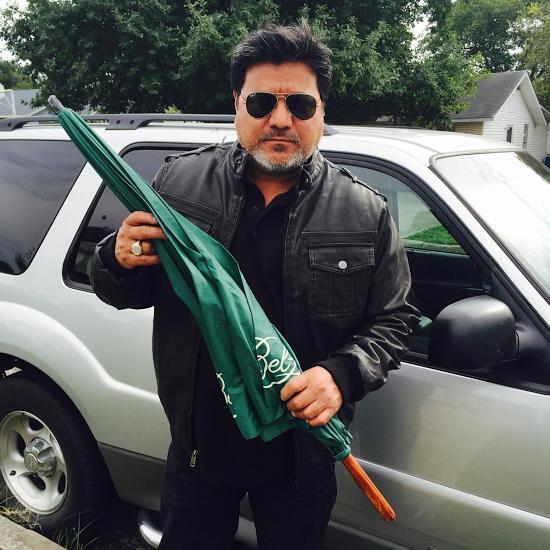This Week in 2007 is a weekly column looking back on Lindsay Lohan, the first iPhone, George W. Bush, and everything else we loved about the year 2007.
Ten years ago today, Britney Spears slouched in the passenger seat of her silver Mercedes outside a Mobil gas station in Tarzana, California. A few days earlier, she had shaved her head after fleeing rehab. Her second cousin twice removed, Alli Sims, sat at the wheel, while the X17 photo agency’s paparazzi surrounded the vehicle. They shot pictures of Britney one by one, their flash bouncing off her shaved head. When Britney turned her gaze toward a videographer named Daniel “Dano” Ramos, she looked less like a pop star and more like the tragic Greek heroine Medea.
Videos by VICE
“Are you doing OK?” Ramos asked Britney. “I’m concerned about you.”
She didn’t respond. Several minutes later, outside a Jiffy Lube, Ramos and an X17 photographer continued filming Britney. “Please, guys, don’t do this!” Sims yelled. But it was too late. Britney had already rolled out of her car, yelling, “Fuck you!” as she swung her umbrella at Ramos’s Ford Explorer like she was wielding Excalibur. Britney then dropped the umbrella, ran into her car, and sped off. Another photographer picked it up and then, according to Buzzfeed, handed it to Ramos.
“It was a bad moment in her life,” Ramos says in an exclusive interview with Broadly. “Unfortunately it was captured.”
Read more: How 2007 Became a Meme
Since then “the umbrella incident” has become a pop culture milestone shared via Tumblr GIFs and reenacted in a Lifetime biopic. The images have been compared to something out of a kitschy John Waters film—the self-proclaimed Miss American Dream attacking cameramen; a good girl gone bald—but over the years, they have taken on a more potent, almost mythical meaning thanks to fans and writers who believe Britney’s personal trouble (she was placed under two 5150 psychiatric holds in 2008) and subsequent comeback have made her an unintentional feminist icon. With her umbrella, she was literally striking back at the media after years of often sexist public scrutiny.
For Ramos, February 21, 2007 was just another average night in the life of a working class paparazzo circa-2007. “Another day, another drama,” as Britney would later sing. Although TMZ has reported he was selling the umbrella (he briefly listed it alongside his car on eBay), Ramos has kept the umbrella and continued to drive his Ford Explorer as mementos of his younger years as a paparazzo. (Mileage to date on the SUV: over 200,000.) Today, Ramos has finally decided to auction off the umbrella, a prized mid-2000’s artifact. He’s promising to donate 50 percent of proceeds to a charity of Britney’s choice (her publicist, Jeff Raymond, did not return a request for comment) and also hopes to clarify the context of the umbrella night while promoting his 2010 documentary Paparazzi: Full Throttle LA, which recently received distribution.
“They thought I was just out to make money at the time,” he says. “It was just a moment I captured.”
Ramos, now 49, lives in his hometown of San Antonio, Texas, where he grew up obsessed with movies. Like a kid out of The Last Picture Show, he was addicted to the stories of the silver screen. In the early 2000s, he worked on sets of local films in Texas, and in 2002, he scored his dream job, a producing gig at an independent film company. He moved to Hollywood.
For three years, Ramos was “living the life.” When his contract expired in 2005, though, his employer chose to not renew it. Ramos started looking for a new project. In his apartment building, he met a neighbor, Tuan Pham, who worked as a paparazzi photographer for the then burgeoning X17. According to Atlantic reporter David Samuels, X17 owner François “Regis” Navarre had assembled “gangs of immigrant kids” known for bringing home the most scandalous loot in town. “I could make a documentary about what these guys go through,” Ramos recalls thinking. Ramos convinced Pham to let him film him.
Riding shotgun in Pham’s car, Ramos learned the in’s and out’s of the paparazzi world. Regis heard about Ramos’s cinematography skills. “When they saw my video, they started to realize that they could sell video as well,” Ramos explains. Regis offered Ramos a freelance position as one of X17’s first videographers. “That tied in to pay the bills,” Ramos says. “I ended up turning out from a filmmaker to falling right in the [paparazzi] trap myself. I saw there was money to be made.”
The mid-2000s was a boom period for paparazzi. US Weekly, Star, and a slew of other magazines chronicled the lives of celebrities like they were Dickens characters in serialized novels. The rags depended on accompanying photos that ranged from sacrilegious to mundane, actresses cheating on boyfriends with directors to starlets buying kale at Whole Foods. They bought these images from X17 and other agencies that employed paparazzi.

Ramos with the immortal umbrella. Photo by Daniel Ramos, courtesy of Drop Zone Films, LLC
Celebrities have long complained about photographers hounding them, but Ramos describes the general relationship between paparazzi and their subjects as more complicated. “The celebrities want the photos taken when their careers aren’t doing well and they need to promote. They go out and try to become the news,” he says. “When they get back on top, they don’t need you anymore… It’s a bipolar situation on both parties.” In a previous interview with Broadly, Spencer Pratt explains, “Look, all the big stars: Do you think that Brad and Angelina randomly got caught on the beach in Africa in the middle of nowhere where they reveal they’re dating? No! These are strategic moves.”
For More Stories Like This, Sign-Up for Our Newsletter
On their end, paparazzi were often just trying to make a living in the mid-2000s. For a scandalous, news-breaking photo, Ramos estimates a photographer could earn over $100,000, but most the time, they scored a few thousand a shot. Nearly all worked freelance for a few thousand a pic and zero benefits. “Not one paparazzo is going to make the same as another paparazzo depending on who you are and what kind of shots you got,” Ramos says. As Samuels reported in the Atlantic, many were hard-working immigrants. The relationship between paparazzi and their famous subjects were one of the few places in America where the working class can interact in a symbiotic relationship with the upper class on a daily basis.
The biggest boon came from Britney. “Britney was very popular with the media,” Ramos says. “Everyone wanted to see what Britney was up to.” In 2007, the Atlantic reported that Britney images accounted for $3 million in X17’s sales, roughly 25 percent of the company’s total income.
Besides her value to the tabloids that bought pap photos, Ramos believes paparazzi loved Britney because she treated them like friends. Photographers accompanied her on the majority of her activities, whether it was to Rite Aid or a night club with Paris Hilton. “The difference between Britney and the other celebrities is she’s a sweet girl,” Ramos explains. “She was able to have conversations with the paparazzi.” One day, Ramos remembers Britney calling for paparazzi to help her when she got a flat tire on the side of the highway. She even dated a paparazzo named Adnan Ghalib later in 2007.

Britney parties in Las Vegas with P. Diddy and Paris Hilton. Photo by Johnny Nunez, courtesy of Getty Images
“That time in Britney’s life, she [dated a photographer], because that’s how much she was with us,” Ramos says. “It was like she would jump in the water in her pink panties on Santa Monica Beach or whatever, and everyone wanted to know what she would do next… Britney just loved it. She just enjoyed it, but there were times that it caught up to her. She didn’t give us the memo. She didn’t email us, so we didn’t know when it would be good for her.”
On the night of the umbrella incident, he recalls her appearing different. Britney wasn’t typically unresponsive when Ramos spoke to her. “She knew us already from being out in the streets,” Ramos recalls. “We didn’t know [something was wrong]. We were just going on a daily basis until we figured out what was happening at the time was not good. At the Mobil gas station [on the night of the umbrella incident], I told her I was worried about her.”
Read more: This Is How Paris Hilton Fooled the Entire United States of America
What happened next Ramos never imagined would have happened. Britney was breaking the pop star motif. He believes the night, and Britney’s life in 2007 in general, have lived on because they had a beginning, middle, and an end. “[All paparazzi] know they have to tell a story because if not it’s not going to be big enough,” he says. “That’s what I was able to capture with Britney Spears. I was able to catch a story and finish it.”
A few months later in July 2007, Britney apologized on her website: “I apologize to the pap for a stunt that was done 4 months ago regarding an umbrella. I was preparing my character for a role in a movie where the husband never plays his part so they switch places accidentally. I take all my roles very seriously and got a little carried away. Unfortunately I didn’t get the part.” Ramos appreciated the note. “She apologized,” he says. “It wasn’t like I did something bad.”
Ramos quit working as a paparazzo to focus on filmmaking in 2013 shortly after Kanye West allegedly assaulted him. (West settled Ramos’s lawsuit against him two years later.) Ramos had entered the celebrity world to direct a movie about paparazzi. He never intended to inhabit the world he wanted to document as a filmmaker. When he became a videographer himself, he had planned to only briefly pursue celebrities for money. It was never supposed to become a full-time job, let alone a part of an iconic pop culture moment. Like Britney, Ramos says, he was “just caught in that situation.”




